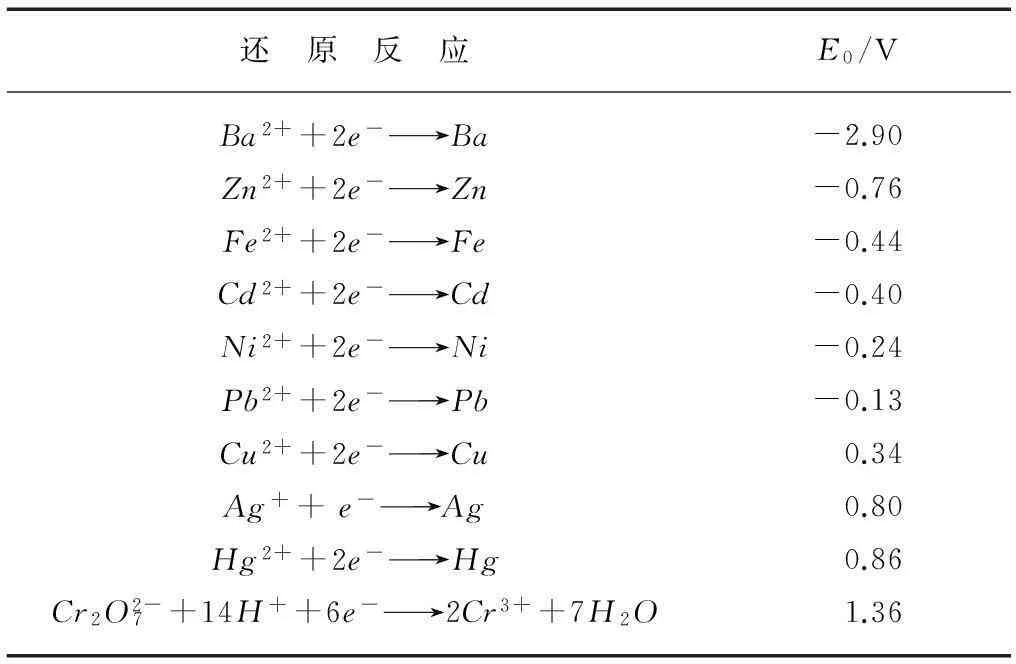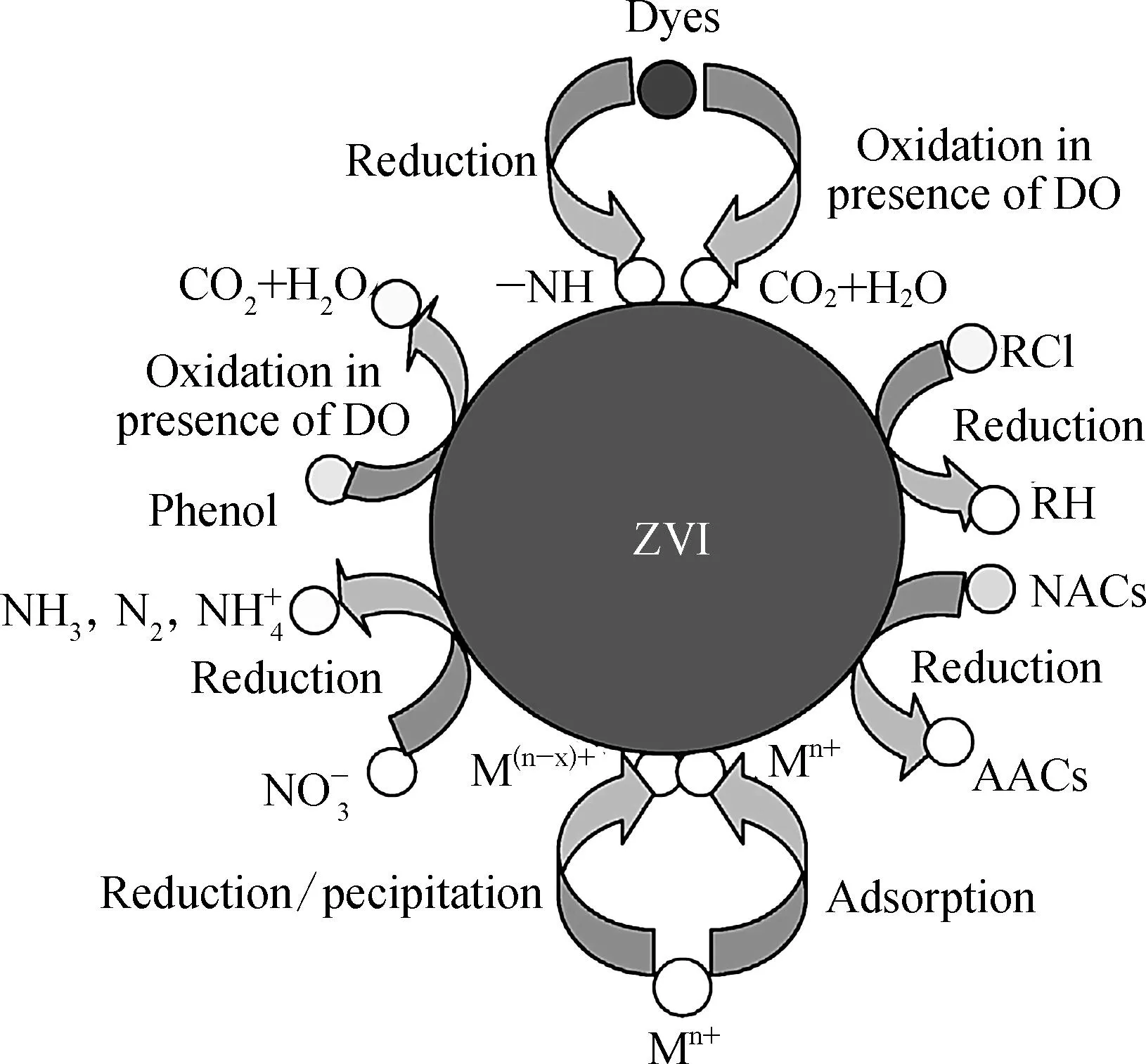零价铁(ZVI)工艺处理水中铬、砷污染的研究进展综述
2016-01-15孙翠珍,孙玉林,张文辉等
行业导向与研究进展
零价铁(ZVI)工艺处理水中铬、砷污染的研究进展综述
孙翠珍1,孙玉林1,张文辉2,张晓蕊1,马征1,邹彦江1,朱大伟1
(1. 山东建筑大学市政与环境工程学院,山东济南250101; 2. 山东省环境保护科学研究设计院,山东济南250013)
摘要工业和城市活动导致水体中的铬、砷污染物浓度升高,严重威胁人类的健康。近年来,使用零价铁(ZVI)处理地下水和废水中的毒性污染物备受关注,该法被证明有较高的处理效果。该文综述了ZVI处理水中铬、砷污染的研究进展,并对未来的研究方向提出了展望。
关键词零价铁(ZVI)铬砷水处理研究进展
中图分类号:X52文献标识码: A
[收稿日期]2014-09-15
[基金项目]省财政厅项目(No.SDZS-2012-SHBT01);山东建筑大学博士基金(No.XNBS1228)
[作者简介]孙翠珍(1978—),女,副教授,博士,研究方向为水处理理论与技术。电话: 15863148309;E-mail: sczp901@126.com。
Overview of Research Progress on ZVI Process for Water Treatment of Chromium and Arsenic Pollution
Sun Cuizhen1, Sun Yulin1, Zhang Wenhui2, Zhang Xiaorui1, Ma Zheng1, Zou Yanjiang1, Zhu Dawei1
(1.SchoolofMunicipalandEnvironmentalEngineering,ShandongJianzhuUniversity,Ji’nan250101,China;
2.ShandongAcademyofEnvironmentalScience,Ji’nan250101,China)
AbstractIndustrial and urban activities have made concentration of chromium and arsenic increase in water, which threatens the health of human being. In recent years, zero-valent iron (ZVI) for treatment of toxic species in groundwater and wastewater attracts widespread attention and has a better effect on water treatment. The research process on ZVI process for water treatment of chromium and arsenic pollution was review in this paper and research direction was raised.
Keywordszero-valent iron (ZVI)chromiumarsenicwater treatmentresearch progress

洁净水是人类赖以生存的自然资源之一。由于工业化和城市化的扩张,世界范围内的用水量每15年就要翻一番。同时,工业和城市活动导致越来越多的铬、砷进入水环境,威胁全世界人类的健康。世界卫生组织的数据显示由于水资源的缺乏,世界上40%的人口(即超过20亿人)无法获取充足和清洁的饮用水。
铁是地壳中含量第四多的元素。由于ZVI具有无毒、量大、便宜、易得而且处理成本低的优点,近几十年来受到广泛的研究。ZVI是一种具有标准氧化还原电位(E0=-0.44V)的活性金属。当它和氧化性污染物(比如铬)反应时会表现出高效的还原性[1],如表1所示。电子从ZVI转移到污染物中,使后者转为无毒或低毒性物质[2],如图1所示。另一方面,ZVI在溶解氧存在的条件下转移两个电子到氧分子,以生成过氧化氢。

表1 25℃时金属标准氧化还原电位

图1 零价铁与不同污染物的反应机理示意图 Fig.1 Schematic Diagram of Reaction Mechanism of ZVI with Different Contaminants
(1)
生成的过氧化氢同样可以被ZVI还原成水。
(2)
此外,过氧化氢和亚铁离子结合(芬顿反应)能生成具有强氧化性的羟基自由基(·OH)。
(3)
由反应式(1)和(2)可知反应过程中产生了Fe2+。Fe2+能够触发羟基自由基的生成,加速污染物的氧化。反应式(1)~(3)消耗H+生成OH-,导致pH升高。Fe2+和OH-浓度升高会产生Fe(OH)2或Fe(OH)3沉淀,在pH较高的情况下,Fe2+的释放会减缓。
(4)
(5)
近年来,ZVI已经成功应用于水中的多种污染物处理,例如三氯乙烯[3,4]、硝酸盐[5]、砷[6]、铬[7]、苯酚[8]和硝基苯[9]。汤姆生科技数据库的数据显示,近十年来90%的环境类杂志发表过有关ZVI的文献。研究ZVI的文献越来越多,这反映出人们对ZVI修复和处理水污染的期望。
此外,将ZVI与其他水处理方法进行联用的技术也表现出较好的处理效果。二元金属体系微电解是将其他金属覆在零价铁表面,促使其在作用空间上形成电场,构成微小原电池,加快氧化还原反应的进行。与零价铁结合的可渗透反应墙(ZVI-PRBs)已经被确认是一种可行、低成本的地下水原位修复技术,自1995年以来,有超过200个ZVI-PRBs被应用于实际的水处理工程中。纳米级零价铁(nZVI)的直径只有1~100nm,颗粒小、比表面积大,反应活性高,能有效转化多种环境污染物,广泛用于环境领域。
1ZVI处理水中的铬污染
零价铁最早被应用于处理电镀废水等含重金属离子的污水。与有机污染不同,重金属污染不能生物降解并易于在生物体内富集,而且许多金属离子具有毒性和致癌性。Cr(Ⅵ)是冶金、鞣革和电镀行业常见的重金属污染物,它的毒性、致癌性及在地下水中的迁移性对环境有很大危害[10]。在中国,它被当作优先控制污染物。近年来,ZVI高效去除多种金属离子(Ni2+、Pb2+、Cu2+和Zn2+)已经被报道,但大多数ZVI的研究集中于处理Cr(Ⅵ)。

反应机理: Cr(Ⅵ)即时吸附在ZVI表面发生电子转移,Cr(Ⅵ)被还原为Cr3+同时ZVI被氧化为Fe3+,紧接着产生Cr和Fe的氢氧化物混合沉淀,如式(6)~(7)所示。
(6)
(7)

合成的nZVI具有更小的粒径(10~30nm)、更大的比表面积和反应活性,因此nZVI的除铬效果远高于ZVI粉末。Li等[14]研究了nZVI去除水中Cr(Ⅵ)的效果,每克nZVI可处理65~110mg的Cr6+。柳听义等[15]利用柠檬酸处理后的nZVI对Cr(Ⅵ)的去除进行了研究,表明HA与Cr(Ⅵ)可以形成稳定的螯合物,显著降低溶液中的Cr(Ⅵ)浓度。钱慧静[16]在制备nZVI时添加稳定剂羧甲基纤维素(CMC),结果显示可以有效防止nZVI的聚合,提高nZVI的利用率,从而加强Cr(Ⅵ)的去除。
2ZVI处理水中的砷污染
砷在自然水体中大多以As(Ⅲ)和As(Ⅴ)的形式存在。世界卫生组织(WHO)把砷定义为第一类优先污染物,并确定其在饮用水中的限值为0.01mg/L。为了达到砷浓度标准,ZVI技术被引用到砷的去除和修复当中。
ZVI除砷是多种反应过程共同作用的结果,所以机理非常复杂。普遍认可的反应过程包括吸附、还原、表面沉淀、与铁腐蚀产物的共沉淀[17]。在处理过程中ZVI根据水质条件的变化,对水体砷污染的去除途径也会发生改变。归纳目前的研究成果可知ZVI去除水体中砷的反应主要包括厌氧和有氧条件下两个方面。在相对厌氧的条件下,砷主要是通过沉淀作用被去除;在好氧条件下,砷则被吸附于ZVI及其腐蚀产物的表面而得以去除。事实上,ZVI对水体砷的去除机理非常复杂,直到目前仍然没有完全弄清。

与As(Ⅴ)相比,As(Ⅲ)具有更高的流动性和毒性,也更难去除。Klas等[6]在有限的曝气和酸性条件下利用ZVI去除As(Ⅲ)。该条件下ZVI表面形成了Fe(Ⅱ)的固态中间产物,增大了表面积和还原性,从而提高了As(Ⅲ)的还原和去除效果。Wan等[23]将As(Ⅲ)的生物氧化和ZVI除砷相结合,取得了较高的ZVI除砷容量(>70mg As/Fe)。Katsoyiannis等[24]研究了在pH为3~11的曝气水中ZVI氧化As(Ⅲ)的动力学和机理,结果发现在较低pH下,As(Ⅲ)的氧化剂主要是羟基自由基,As(Ⅲ)通过芬顿反应氧化然后被新形成的含水氧化铁吸附。

3ZVI处理水中的铬、砷复合污染
砷常与重金属离子共存,例如在过去的60多年里,铬—铜—砷已经被广泛应用于木材防腐剂中。但应用ZVI同步除铬除砷却缺乏相关的研究。ZVI除铬主要是还原过程,然而去除As(Ⅴ)主要依靠铁腐蚀产物的吸附和共沉淀。
Liu等[28]研究了铬—砷共存的相互作用和玻璃酸、碳酸盐对ZVI同步除铬除砷反应的影响,发现Cr(Ⅵ)的去除不受As(Ⅴ)和玻璃酸的影响,但是As(Ⅴ)的去除却受到Cr(Ⅵ)的抑制。Mark等[29]研究了在富里酸和玻璃酸存在时ZVI去除Cr(Ⅵ)和As(Ⅴ)的机理,发现富里酸和玻璃酸不参与Cr(Ⅵ)的还原反应。Mark等[30]结合ZVI和氧化铁涂层砂(IOCS)去除地下水中共存的Cr(Ⅵ)和As(Ⅴ),对砷、铬的去除效果比单独使用ZVI或IOCS好。金属提取试验表明,As(Ⅴ)主要由IOCS和铁腐蚀产物去除,Cr(Ⅵ)主要由ZVI和它的腐蚀产物去除。此外,利用ZVI和IOCS混合柱处理地下水中的Cr(Ⅵ)和As(Ⅴ),完全混合态的ZVI和IOCS对铬、砷的去除率最高。
4未来ZVI处理水中铬、砷污染的研究方向
使用ZVI处理水中的铬、砷污染物具有经济、简便、高效等优势,而且随着纳米技术的发展,针对nZVI的研究也越发广泛。但无论是nZVI还是普通ZVI,都无法避免钝化、板结的产生。因此,有效避免钝化、板结的产生将是一个新的研究方向。目前,关于ZVI去除铬、砷污染的研究大部分还停留在实验室研究阶段,零价铁除铬除砷在水处理及受污染地下水原位修复上的工程应用还较少, 在应用过程中的参数设计及优化等都有待于进一步研究。此外,单一的ZVI技术难于处理实际污水或地下水,因此研究ZVI与其他技术的复合方法很有必要。
参考文献
[1] 贾汉忠,宋存义,李晖.纳米零价铁处理地下水污染技术研究进展[J].化工进展,2009,28(11): 2028-2034.
[2] Fenglian Fu, Dionysios D, Hong Liu. The use of zero-valent iron for groundwater remediation and wastewater treatment: A review[J]. Journal of Hazardous Materials, 2014, 26(7): 194-205.
[3] C Su, RW Puls, T A Krug,etal. A two and half-year-performance evaluation of a field test on treatment of source zone tetrachloroethene and its chlorinated daughter products using emulsified zero valent iron nanoparticles[J]. Water Res., 2012, 46(5): 5071-5084.
[4] P J Dorathi, P Kandasamy. Dechlorination of chlorophenols by zero valent iron impregnated silica[J]. J. Environ. Sci., 2012, 24(3): 765-773.
[5] Y H Hwang, D G Kim, H S Shin. Mechanism study of nitrate reduction by nano zero valent iron[J]. J. Hazard. Mater., 2011, 23(13): 1513-1521.
[6] S Klas, D W Kirk. Advantages of low pH and limited oxygenation in arsenite removal from water by zero-valent iron[J]. J. Hazard. Mater., 2013, 25(6): 77-82.
[7] X Qiu, Z Fang, X Yan,etal. Emergency remediation of simulated chromium (Ⅵ)-polluted river by nanoscale zero-valent iron: laboratory study and numerical simulation[J]. Chem. Eng. J., 2012, 44(9): 358-365.
[8] A Shimizu, M Tokumura, K Nakajima,etal. Phenol removal using zero-valent iron powder in the presence of dissolved oxygen: roles of decomposition by the Fenton reaction and adsorption/precipitation[J]. J. Hazard. Mater., 2012, 24(10): 60-67.
[9] W Yin, J Wu, P Li,etal. Experimental study of zero-valent iron induced nitrobenzene reduction in groundwater: the effects of pH, iron dosage, oxygen and common dissolved anions[J]. Chem. Eng. J., 2012, 44(5): 198-204.
[10] N Cissoko, Z Zhang, J H Zhang,etal. Removal of Cr(Ⅵ) from simulative contaminated groundwater by iron metal[J]. Process Saf. Environ., 2009, 87(8): 395-400.
[11] Q Wang, N Cissoko, M Zhou,etal. Effects and mechanism of humic acid on chromium(Ⅵ) removal by zero-valent iron (Fe0) nanoparticles[J]. Phys. Chem. Earth, 2011, 36(1): 442-446.
[12] T Z Liu, P H Rao, I M C Lo. Influences of humic acid, bicarbonate and calcium on Cr(Ⅵ) reductive removal by zero-valent iron[J]. Sci. Total Environ., 2009, 40(7): 3407-3414.
[13] T Z Liu, I M C Lo. Influences of humic acid on Cr(Ⅵ) removal by zero-valent iron from groundwater with various constituents: implication for long-term PRB performance[J]. Water Air Soil Pollut., 2011, 21(6): 473-483.
[14] Li Xiaoqin, Cao Jiasheng, Zhang Weixian. Stoichiometry of Cr(Ⅵ) immobilization using nanoscale zerovalent iron (nZVI): A study with HR-XPS[J]. Ind. Eng. Chem. Res., 2008, 47(7): 2131-2139.
[15] 柳听义,赵林,谭欣,等.纳米零价铁去除垃圾渗滤液中铬(Ⅵ) 的性能及机理研究[J].环境化学,2010,29(3): 429-433.
[16] 钱慧静.CMC对纳米零价铁去除污染水体中六价铬的影响[D].杭州: 浙江大学,2008.
[17] M S H. Mark, P H Rao, I M C Lo. Effects of hardness and alkalinity on the removal of arsenic(V) from humic acid-deficient and humic acid-rich groundwater by zero-valent iron[J]. Water Res., 2009, 43(9): 4296-4304.
[18] J M Triszcz, A Porta, F S G Einschlag. Effect of operating conditions on iron corrosion rates in zero-valent iron systems for arsenic removal[J]. Chem. Eng. J., 2009, 41(18): 431-439.
[19] V Tanboonchuy, J C Hsu, N Grisdanurak,etal. Impact of selected solution factors on arsenate and arsenite removal by nanoiron particles[J]. Environ. Sci. Pollut. Res., 2011, 18 (11): 857-864.
[20] F Sun, K A Osseo-Asare, Y Chen,etal. Reduction of As(Ⅴ) to As(Ⅲ) by commercial ZVI or As(0) with acid-treated ZVI[J]. J. Hazard. Mater., 2011, 23(1): 311-317.
[21] M S H Mark, P H Rao, I M C Lo. Effects of hardness and alkalinity on the removal of arsenic(V) from humic acid-deficient and humic acid-rich groundwater by zero-valent iron[J]. Water Res., 2009, 43(9): 4296-4304.
[22] P H Rao, M S H Mark, T Z Liu,etal. Effects of humic acid on arsenic(V) removal by zero-valent iron from groundwater with special references to corrosion products analyses[J]. Chemosphere, 2009, 27(5): 156-162.
[23] J Wan, J Klein, S Simon,etal. As(Ⅲ) oxidation by Thiomonas arsenivorans in up-flow fixed-bed reactors coupled to As sequestration onto zero-valent iron-coated sand[J]. Water Res., 2010, 44(8): 5098-5108.
[24] I A Katsoyiannis, T Ruettimann, S J Hug. pH dependence of Fenton reagent generation and As(Ⅲ) oxidation and removal by corrosion of zero valent iron in aerated water[J]. Environ. Sci. Technol., 2008, 42(20): 7424-7430.
[25] R D Ludwig, D J A Smyth, D W Blowes,etal. Treatment of arsenic, heavy metals, and acidity using a mixed ZVI-compost PRB[J]. Environ. Sci. Technol., 2009, 43 (9): 1970-1976.
[26] V Tanboonchuy, J C Hsu, N Grisdanurak,etal. Gas-bubbled nano zerovalent iron process for high concentration arsenate removal[J]. J. Hazard. Mater., 2011, 23(11): 2123-2128.
[27] V Tanboonchuy, N Grisdanurak, C H Liao. Background species effect on aqueous arsenic removal by nano zero-valent iron using fractional factorial design[J]. J. Hazard. Mater., 2012, 24(12): 40-46.
[28] T Z Liu, P H Rao, M S H Mark,etal. Removal of co-present chromate and arsenate by zero-valent iron in groundwater with humic acid and bicarbonate[J]. Water Res., 2009, 43(10): 2540-2548.
[29] M S H Mark, I M C Lo. Influences of redox transformation, metal complexation and aggregation of fulvic acid and humic acid on Cr(Ⅵ) and As(Ⅴ) removal by zero-valent iron[J]. Chemosphere, 2011, 29(8): 234-240.
[30] M S H Mark, P H Rao, I M C Lo. Zero-valent iron and iron oxide-coated sand as a combination for removal of co-present chromate and arsenate from groundwater with humic acid[J]. Environ. Pollut., 2011, 15(9): 377-382.
